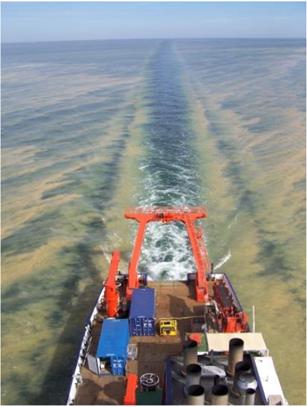Lavish blue-green algae: Surprising supply of amino acids for zooplankton

r/v METEOR passing a decaying blue-green algae bloom Andreas Raeke, DWD
Our seas are not everywhere fertile and full of colourful, diverse life. Wide areas of the world's oceans are naturally poor in nutrients. The fact that marine life nevertheless develops is to a large extent the work of cyanobacteria (colloquially: blue-green algae). Thanks to their unique ability to harness atmospheric nitrogen – a process known in the scientific community as nitrogen fixation – the small amounts of phosphorus that a nutrient-poor ocean has to offer are sufficient for them to form massive blooms.
However, these relatively large and often toxic organisms are unsuitable for direct use in the food web. Rather, it is the amino acids produced by the blue-green algae that supply the food web, so that zooplankton and fish can also be fed. So far it has been largely unclear how high the amino acid synthesis is during nitrogen fixation and what influence the stage of the bloom has.
Natalie Loick-Wilde and her colleagues used a research cruise to the central Baltic Sea in summer 2015 to take a closer look at the supply of amino acids at the peak as well as at the beginning and advanced decay of a blue-green algae bloom. The Baltic Sea in general is not a nutrient-poor sea, but in midsummer its nitrogen and phosphorus reserves are largely depleted.
Then, even in the Baltic Sea, which is suffering from over-fertilization, it is “blue-green algae time”. At four stations in the western and central Baltic Sea, the team sampled blue-green algae blooms in different stages, incubated the samples on deck already during the cruise and later determined the total nitrogen as well as the amino acid-specific nitrogen content. Using stable nitrogen isotopes in the amino acids, they developed for the first time an approach to investigate the synthesis of 13 amino acids during nitrogen fixation.
“We are one of the few laboratories in the world that can apply compound-specific nitrogen isotope analysis in amino acids (CSIA-AA for short),” Natalie Loick-Wilde reports. “It is this method that allowed us to develop the approach to see how much essential nutrients are being produced for a food web.”
It turned out that at a time when the blue-green algae themselves already largely stop their activity, so much amino acids are still produced in the bloom that this inevitably must have consequences for the food web. In anticipation of a proposed global increase of cyanobacteria blooms this excessive supply of nutrients before winter is a relevant parameter for the seasonal growth cycle of zooplankton – but also for fish-stocks. Its development and consequences should be further pursued.
Reference:
Loick-Wilde, N., S.C. Weber, E. Eglite, I. Liskow, D. Schulz-Bull, N. Wasmund, D. Wo-darg, and J. P. Montoya. 2017. De novo amino acid synthesis and turnover during N2 fixation. Limnology & Oceanography, doi: 10.1002/lno.10755
Scientific experts:
Dr. Natalie Loick-Wilde| +49 381 5197-206 | natalie.loick-wilde@io-warnemuende.de
Press and public relation:
Dr. Barbara Hentzsch | +49 381 5197-102 | barbara.hentzsch@io-warnemuende.de
IOW is a member of the Leibniz Association with currently 91 research institutes and scientific infrastructure facilities. The focus of the Leibniz Institutes ranges from natural, engineering and environmental sciences to economic, social and space sciences as well as to the humanities. The institutes are jointly financed at the state and national levels. The Leibniz Institutes employ a total of 18.100 people, of whom 9.200 are scientists. The total budget of the institutes is 1.6 billion Euros.
Media Contact
All latest news from the category: Life Sciences and Chemistry
Articles and reports from the Life Sciences and chemistry area deal with applied and basic research into modern biology, chemistry and human medicine.
Valuable information can be found on a range of life sciences fields including bacteriology, biochemistry, bionics, bioinformatics, biophysics, biotechnology, genetics, geobotany, human biology, marine biology, microbiology, molecular biology, cellular biology, zoology, bioinorganic chemistry, microchemistry and environmental chemistry.
Newest articles

First-of-its-kind study uses remote sensing to monitor plastic debris in rivers and lakes
Remote sensing creates a cost-effective solution to monitoring plastic pollution. A first-of-its-kind study from researchers at the University of Minnesota Twin Cities shows how remote sensing can help monitor and…

Laser-based artificial neuron mimics nerve cell functions at lightning speed
With a processing speed a billion times faster than nature, chip-based laser neuron could help advance AI tasks such as pattern recognition and sequence prediction. Researchers have developed a laser-based…

Optimising the processing of plastic waste
Just one look in the yellow bin reveals a colourful jumble of different types of plastic. However, the purer and more uniform plastic waste is, the easier it is to…



